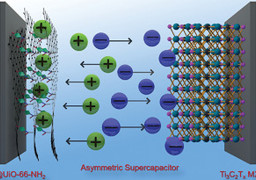[GT] кі нҡЁмңЁ к·ёлһҳн•Җ кё°л°ҳмқҳ мҠҲнҚј м»ӨнҢЁмӢңн„° к°ңл°ң
л®Ңн—Ё кіөкіј лҢҖн•ҷ(Technical University Munich) м—°кө¬нҢҖмқҙ кі нҡЁмңЁ к·ёлһҳн•Җ кё°л°ҳ мҠҲнҚј м»ӨнҢЁмӢңн„°(super capacitor)лҘј к°ңл°ңн–ҲлӢӨ. мҠҲнҚј м»ӨнҢЁмӢңн„°лҠ” м „м§ҖлЎң мӮ¬мҡ©н•ҳлҸ„лЎқ м „кё° мҡ©лҹүмқҳ м„ұлҠҘмқ„ мӨ‘м җм ҒмңјлЎң к°•нҷ”н•ң м»ӨнҢЁмӢңн„°лЎң, ліҙнҶө көҗлҘҳм „мӣҗмңјлЎңл¶Җн„° кіөкёүл°ӣм•„ м¶©м „н•ҙ л‘җкі м „мӣҗмқҙ лҒҠм–ҙ진 кІҪмҡ°м—җ м „л Ҙмқ„ кіөкёүн• лӘ©м ҒмңјлЎң мӮ¬мҡ©н•ңлӢӨ. м—°кө¬нҢҖмқҙ к°ңл°ңн•ң мқҙ м—җл„Ҳм§Җ м ҖмһҘ мһҘм№ҳмқҳ кё°мҙҲлҠ” нҳ„мһ¬ л°°н„°лҰ¬ кё°мҲ м—җ н•„м Ғн•ҳлҠ” м„ұлҠҘмқ„ к°Җ진 мғҲлЎӯкі к°•л Ҙн•ҳл©° м§ҖмҶҚ к°ҖлҠҘн•ң к·ёлһҳн•Җ н•ҳмқҙлёҢлҰ¬л“ң мһ¬лЈҢм—җ мһҲлӢӨ.
мқјл°ҳм ҒмңјлЎң м—җл„Ҳм§Җ м ҖмһҘмқҖ м „мһҗ мһҘм№ҳм—җ м—җл„Ҳм§ҖлҘј м ңкіөн•ҳлҠ” л°°н„°лҰ¬ л°Ҹ м¶•м „м§ҖмҷҖ кҙҖл Ёмқҙ мһҲлӢӨ. к·ёлҹ¬лӮҳ лһ©нҶұ, м№ҙл©”лқј, нңҙлҢҖнҸ° лҳҗлҠ” м°Ёлҹүм—җм„ң мҶҢмң„ мҠҲнҚј м»ӨнҢЁмӢңн„°мқҳ кІҪмҹҒмқҙ м җм җ м№ҳм—ҙн•ҙм§Җкі мһҲлӢӨ.
л°°н„°лҰ¬мҷҖ лӢ¬лҰ¬, мқҙл“ӨмқҖ л§ҺмқҖ м–‘мқҳ м—җл„Ҳм§ҖлҘј л§Өмҡ° л№ лҘҙкІҢ м ҖмһҘн•ҳкі л§Ҳм°¬к°Җм§ҖлЎң л№ лҘҙкІҢ мҳӨн”„лЎңл“ң(offload) н• мҲҳ мһҲлӢӨ. мҳҲлҘј л“Өм–ҙ кё°м°Ёк°Җ м—ӯм—җ л“Өм–ҙк°Ҳ л•Ң м ңлҸҷмқ„ кұ°лҠ” кІҪмҡ° мҠҲнҚј м»ӨнҢЁмӢңн„°лҠ” м—җл„Ҳм§ҖлҘј м ҖмһҘн–ҲлӢӨ м¶ңл°ңн•ҳлҠ” лҸҷм•Ҳ кё°м°Ёк°Җ л§Өмҡ° л№ лҘҙкІҢ л§ҺмқҖ м—җл„Ҳм§ҖлҘј н•„мҡ”лЎң н• л•Ң лӢӨмӢң м ңкіөн• мҲҳ мһҲлӢӨ.
к·ёлҹ¬лӮҳ нҳ„мһ¬к№Ңм§Җ мҠҲнҚј м»ӨнҢЁмӢңн„°мқҳ н•ң к°Җм§Җ л¬ём ңлҠ” м—җл„Ҳм§Җ л°ҖлҸ„к°Җ л¶ҖмЎұн•ҳлӢӨлҠ” кІғмқҙм—ҲлӢӨ.
л®Ңн—Ё кіөкіј лҢҖн•ҷмқҳ м—°кө¬нҢҖмқҙ мқҙм ң к°ңл°ңн•ң кІғмқҖ мҠҲнҚј м»ӨнҢЁмӢңн„°лҘј мң„н•ң к·ёлһҳн•Җ н•ҳмқҙлёҢлҰ¬л“ң мһ¬лЈҢмқҙлӢӨ. мқҙ мһ¬лЈҢлҠ” м—җл„Ҳм§Җ м ҖмһҘ мһҘм№ҳм—җм„ң м–‘к·№(positive electrode)мқ„ мҲҳн–үн•ңлӢӨ. м—°кө¬нҢҖмқҖ мқҙлҘј нӢ°нғҖлҠ„кіј нғ„мҶҢлҘј кё°л°ҳмңјлЎң н•ҳлҠ” мқҙлҜё мһ…мҰқлҗң мқҢк·№(negative electrode)кіј кІ°н•©н•ҳкі мһҲлӢӨ.
мқҙ мғҲлЎңмҡҙ м—җл„Ҳм§Җ м ҖмһҘ мһҘм№ҳлҠ” мөңлҢҖ kgлӢ№ 73kWhмқҳ м—җл„Ҳм§Җ л°ҖлҸ„лҘј лӢ¬м„ұн• лҝҗл§Ң м•„лӢҲлқј, мқҙлҠ” лӢҲмјҲ-кёҲмҶҚ мҲҳмҶҢнҷ”л¬ј л°°н„°лҰ¬мқҳ м—җл„Ҳм§Җ л°ҖлҸ„мҷҖ кұ°мқҳ лҸҷмқјн• лҝҗл§Ң м•„лӢҲлқј kлӢ№ 16kWhмқҳ м „л Ҙ л°ҖлҸ„м—җм„ңлҠ” лҢҖл¶Җ분мқҳ лӢӨлҘё мҠҲнҚј м»ӨнҢЁмӢңн„°ліҙлӢӨ нӣЁм”¬ мҡ°мҲҳн•ң м„ұлҠҘмқ„ л°ңнңҳн•ңлӢӨ. мқҙ мғҲлЎңмҡҙ мҠҲнҚј м»ӨнҢЁмӢңн„°мқҳ 비л°ҖмқҖ м„ңлЎң лӢӨлҘё мһ¬лЈҢмқҳ мЎ°н•©м—җ мһҲлӢӨ. мқҙм—җ нҷ”н•ҷмһҗл“ӨмқҖ мқҙ мҠҲнҚј м»ӨнҢЁмӢңн„°лҘј вҖҳ비лҢҖм№ӯвҖҷмқҙлқј л¶ҖлҘёлӢӨ.
кё°ліё мһ¬лЈҢлҘј кІ°н•©н•ңлӢӨлҠ” 추мғҒм Ғ м•„мқҙл””м–ҙк°Җ л®Ңн—Ё м—°кө¬нҢҖм—җ мқҳн•ҙ мҠҲнҚј м»ӨнҢЁмӢңн„°лқјлҠ” мӢӨн–үмңјлЎң мҳ®кІЁмЎҢлӢӨ. мқҙл“ӨмқҖ нҷ”н•ҷм ҒмңјлЎң ліҖнҳ•лҗң к·ёлһҳн•Җмқҙ мһҲлҠ” м ҖмһҘ мһҘм№ҳмқҳ мғҲлЎңмҡҙ м–‘к·№мқ„ мӮ¬мҡ©н•ҳкі мқҙлҘј MOFлқј н•ҳлҠ” лӮҳл…ё кө¬мЎ°мқҳ кёҲмҶҚ-мң кё° кө¬мЎ°мҷҖ кІ°н•©н–ҲлӢӨ.
к·ёлһҳн•Җ н•ҳмқҙлёҢлҰ¬л“ңмқҳ м„ұлҠҘмқҖ лҶ’мқҖ м „кё° м „лҸ„м„ұлҝҗл§Ң м•„лӢҲлқј, нҒ° 비н‘ң л©ҙм Ғ(specific surface)кіј м ңм–ҙ к°ҖлҠҘн•ң кіөк·№ нҒ¬кё°лҘј кё°л°ҳмңјлЎң н•ңлӢӨ. мҡ°мҲҳн•ң м„ұлҠҘмқҳ мҠҲнҚј м»ӨнҢЁмӢңн„°лҘј мң„н•ҙм„ңлҠ” л„“мқҖ н‘ңл©ҙмқҙ мӨ‘мҡ”н•ҳлӢӨ. мқҙкІғмқҖ м „кё° м—җл„Ҳм§Җ м ҖмһҘмқҳ кё°ліё мӣҗлҰ¬мқё мһ¬лЈҢ лӮҙм—җм„ң л§ҺмқҖ мҲҳмқҳ лҢҖм „ мһ…мһҗ(charge carriers)лҘј мҲҳм§‘н• мҲҳ мһҲлҸ„лЎқ н•ңлӢӨ.
мҲҷл Ёлҗң мһ¬лЈҢ м„Өкі„лҘј нҶөн•ҙ м—°кө¬мӣҗл“ӨмқҖ к·ёлһҳн•Җ мӮ°(graphene acid)мқ„ MOFмҷҖ м—°кІ°н•ҳлҠ” мң„м—…мқ„ лӢ¬м„ұн–ҲлӢӨ. мқҙкІғмқҖ к·ёлһЁлӢ№ мөңлҢҖ 900м ңкіұлҜён„°мқҳ л§Өмҡ° л„“мқҖ лӮҙл¶Җ н‘ңл©ҙмқ„ м ңкіөн•ңлӢӨ.
к·ёлҹ¬лӮҳ мӢ мҶҢмһ¬мқҳ мң мқјн•ң мһҘм җмқҖ мқҙкІғм—җ к·ём№ҳм§Җ м•ҠлҠ”лӢӨ. нҷ”н•ҷм ҒмңјлЎң м•Ҳм •м Ғмқё н•ҳмқҙлёҢлҰ¬л“ңлҘј м–»мңјл Өл©ҙ кө¬м„ұ мҡ”мҶҢ к°„мқҳ к°•н•ң нҷ”н•ҷм Ғ кІ°н•©мқҙ н•„мҡ”н•ҳлӢӨ. кІ°н•©мқҙ лҚ” м•Ҳм •м ҒмқјмҲҳлЎқ мӢ¬к°Ғн•ң м„ұлҠҘ мҶҗмғҒ м—Ҷмқҙ лҚ” л§ҺмқҖ м¶©м „ л°Ҹ л°©м „ мӮ¬мқҙнҒҙмқҙ к°ҖлҠҘн•ҳкё° л•Ңл¬ёмқҙлӢӨ.
비көҗлҘј н•ҙ ліҙмһҗ. кё°мЎҙ лҰ¬нҠ¬ м „м§Җмқҳ мҲҳлӘ…мқҖ м•Ҫ 5,000мЈјкё°мқҙлӢӨ. мқҙлІҲм—җ л®Ңн—Ё м—°кө¬нҢҖмқҙ к°ңл°ңн•ң мғҲлЎңмҡҙ м „м§ҖлҠ” 10,000лІҲмқҳ мӮ¬мқҙнҒҙ нӣ„м—җлҸ„ 90%м—җ к°Җк№Ңмҡҙ мҡ©лҹүмқ„ мң м§Җн•ңлӢӨ.
Reference:
ADVANCED MATERIALS, December 4, 2020, вҖңCovalent Graphene‐MOF Hybrids for High‐Performance Asymmetric Supercapacitors,вҖқ by Kolleboyina Jayaramulu, et al. © 2020 John Wiley & Sons, Inc. All rights reserved.
To view or purchase this article, please visit:
Covalent Graphene‐MOF Hybrids for High‐ Performance Asymmetric Supercapacitors - Jayaramulu - 2021 - Advanced Materials - Wiley Online Library







